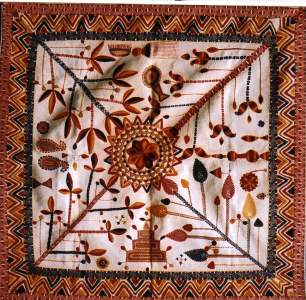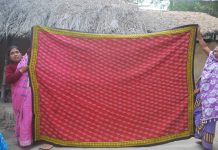The kantha, from the Sanskrit term kontha (rags), is a quilt of recycled old cloth indigenous to Bangladesh, West Bengal and Bihar—where it is known as sujni. It is made by women of all communities, except hill communities and ethnic groups, for domestic, ceremonial or ritual purposes.
Old saris, dhotis and lungis are preserved to make coverlets, prayer rugs, puja ashons (seats), spreads for guests, pillow covers, wraps for books and other valuables. Traditionally, thread was drawn from sari borders and twisted together. Motifs were drawn from the homestead, from women’s domestic lives, festivals, flowers, trees, vines, Islamic culture and Hindu traditions.

The simple running stitch is the predominant stitch, used to embroider the spaces between the motifs as well as the motifs themselves. Worked in a variety of ways, the running stitch can create the ripples so characteristic of the field of the kantha, be used to fill motifs, and, worked parallel to the stitches of the preceding row or slightly obliquely, produce different visual and textural effects. Other embroidery stitches such as buttonhole, satin, chain, stem, backstitch, etc. are also to be found in kanthas. Contemporary kanthas from Bangladesh have a smaller repertoire of stitches, while kanthas from West Bengal tend to use a lot of herringbone.
The term nakshi kantha has come to distinguish the embroidered kantha from the functional one – drawing upon the title of Jasim Uddin’s poem Nakshi Kanthar Maath (The Field of the Embroidered Quilt).
Other quilts made in Bangladesh are the lohori, the sujni, and the “carpet” kantha. The lohori is embroidered in close parallel running stitches. The sujni—not to be confused with the Bihar sujni—has a surface layer of new red cloth, with geometrical or floral motifs embroidered in back stitch. The “carpet” kantha is embroidered in cross stitch.
Bibliography
Ahmad, Perveen. The Aesthetics and Vocabulary of Nakshi Kantha. Dhaka: Bangladesh National Museum, 1997.
– – – Bangladesh Kantha Art in the Indo-Gangetic Matrix. Dhaka: Bangladesh National Museum, 2009.
Bangladesh National Museum [Dr. Zinat Mahrukh Banu]. NakshiKantha Catalogue. Dhaka: Bangladesh National Museum, 2008.
Chen, Martha Alter. “Kantha and Jamdani Revival in Bangladesh.” Indian International
Centre Quarterly, Vol. 2:4 (Dec. 1984).
Dutt, G. S. “The Art of Kantha,” Modern Review. Calcutta, 1939.
Ghuznavi,Ruby.“The Tradition of Kantha and Contemporary Trends” Asian Embroidery,Crafts Council of India, 2004.
Hossain, Hameeda. “Organising Women’s Employment Through Kantha Production.” Woven Air.
Jasim Uddin. The Field of the Embroidered Quilt (Nakshi Kanthar Maath). 1939. Trans. E. M. Milford. Revised W. Mc Dermott. Dhaka, 1964.
Kramrisch, Stella. “Kantha.” Journal of the Indian Society of Oriental Art, Vol. 7 (1939).
Mason, Darielle,ed. Kantha: The Embroidered Quilt of Bengal. Philadelphia: Philadelphia Museum of Art, 2009.
National Crafts Council of Bangladesh. Textile Traditions of Bangladesh. Dhaka: National Crafts Council of Bangladesh, 2005
Sayeedur, Mohammad. “Symbols and Rituals in the Art of the Nakshi Kantha.” Woven Air.
Whitechapel Art Gallery. Woven Air: The Muslin and Kantha Tradition of Bangladesh. London: Whitechapel Art Gallery, 1988.
Zaman, Niaz. The Art of Kantha Embroidery. 1981. Third revised edition. Dhaka: The
University Press Ltd., 2012.
—. “Women’s Words/ Women’s Voices in the Kantha.” Kantha: The Embroidered Quilt of
Bengal.






[…] Sanskrit term of Kantha is referred to as “rags”. It is a woman’s art, where the Bengali women/housewives used […]
[…] and Origin The Sanskrit term of Kantha is referred to as “rags”. It is a woman’s art, where the Bengali women/housewives used […]